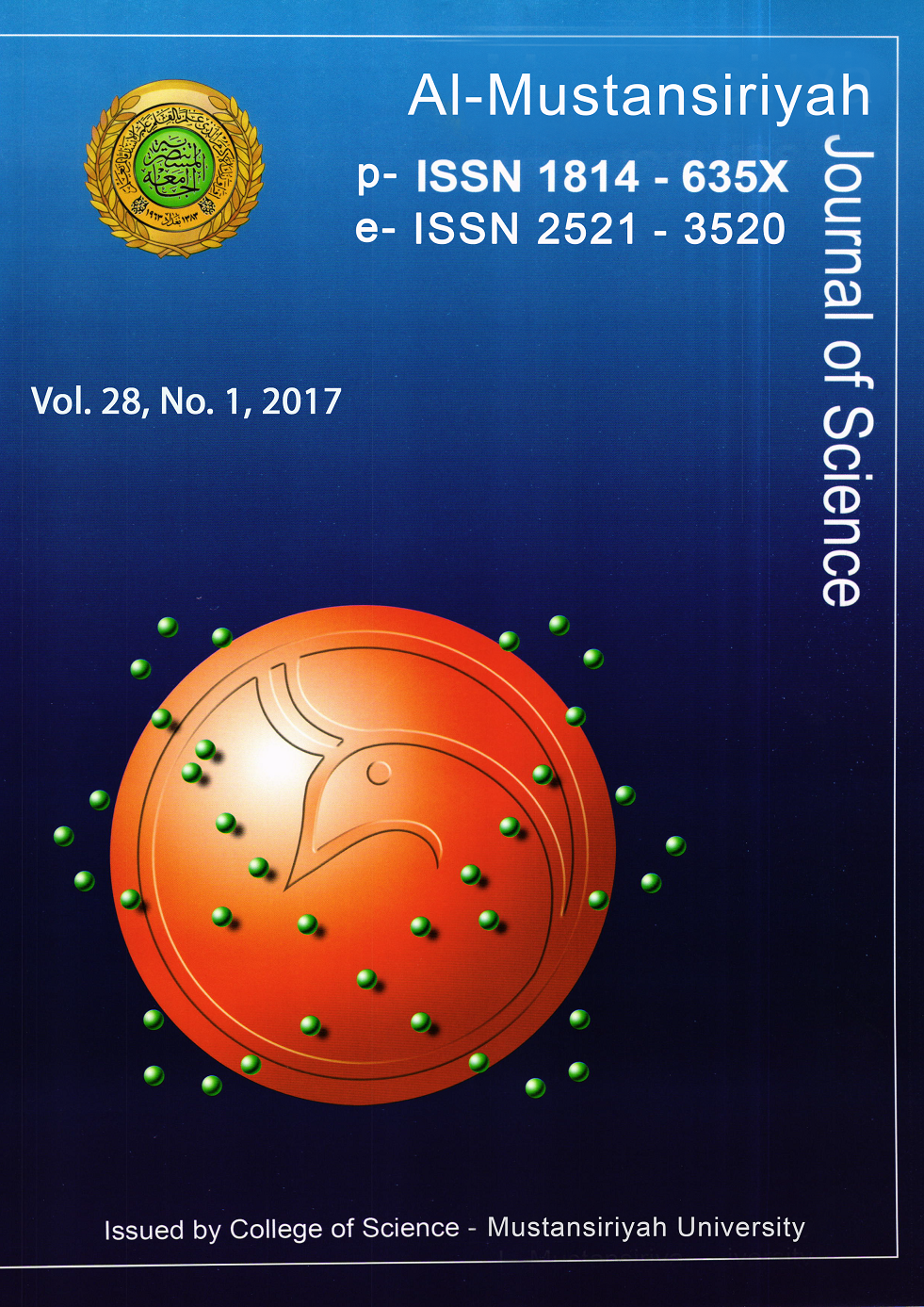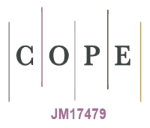Antimicrobial activity of Micrococcus luteus Cartenoid pigment
DOI:
https://doi.org/10.23851/mjs.v28i1.314Keywords:
Micrococcus luteus, Cartenoid piment and Biofilm.Abstract
Cartenoids are group of pigments, with enormous types different structurally and functionally, have colors range from red to yellow found in a wide variety of plants, fungi, algae and bacteria. The animals took from food because they cannot make it, on contrary, the plants and microbes produce them due to subjection to environment. The aim of the study is to isolate and characterize the cartenoid pigment from Micrococcus luteus. The pigment extraction was done by acetone, and then was characterized with UltraViolet-Visible spectroscopy (UV–Vis) and Fourier Transform Infrared (FTIR) spectroscopy. Then, it was tested for antibacterial activity against five different bacterial isolates and antifungal activity tests against six different fungal isolates by well diffusion method. The results found that, the extracted pigment having antibacterial activity and antifungal activity and having the ability to absorb UVA rays within the range of 300-500 nm. There was no significant difference in antimicrobial effect of pigment, even when the extraction and isolation were done by two culture mediums (Nutrient Broth and Luria Bertani Broth). There were considerable inhibition percentages of adhesion after subjection to Cartenoid pigment ranged between (5.71, 23.84) % for Klebsiella spp. and Pseudomonas aeruginosa respectively and all the 11 isolate changed from Biofilm producer to non-producer. The isolated compound can be used against different bacterial and fungal infections. So they had a great future in medicine, cosmetics and as a sun protecting agent.Downloads
References
Jagannadham, M.V.; Rao, V.J. and Shivaji, S. The major carotenoid pigment of a psychrotrophic Micrococcus roseus strain: Purification, structure, and interaction with synthetic membranes. Journal of Bacteriol, vol. 173: 7911‑7. 1991. CrossRef
Greenblatt, C.L.; Baum, J.; Klein, B.Y.; Nachshon, S.; Koltunov, V. and Cano, R.J.. Micrococcus luteus – Survival in amber. Microb Ecol, 48: 120‑7.2004
Soliev, A.B.; Hosokawa, K. and Enomoto, K. Bioactive Pigments from Marine Bacteria: Applications and Physiological Roles. Evidence-Based Complementary and Alternative Medicine. Article ID: 670349. 2011
Dunner, W.M. Biofilm, Adhesion seen any good biofilm lately? Clin Microbiol Revie, 15 (2): 155-166. 2002. CrossRef
Jacobs, J.L. and Sundin, G.W. Effect of solar UV‑B radiation on a phyllosphere bacterial community. Appl Environ Microbiol, 67: 5488‑96. 2001. CrossRef
Bhatnagar, I. and Kim, S.K. Immense Essence of Excellence: Marine Microbial Bioactive Compounds. Marine Drugs., 8 (10): 2673-2701. 2010. CrossRef
Liaaen-Jensen, S. and Andrewes, A.G.. "Analysis of Carotenoids and Related polyene Pigments", in "Methods in Microbiology", T Bergan, Editor., Academic Press. pp: 235-255. 1985. CrossRef
Lu, Y.; Wang,L; Xue, Y.; Zhang, C.; Xing, X.H. and Lou, K. Production of violet pigment by a newly isolated psychrotrophic bacterium from a glacier in Xinjiang, China. Biochem Eng J, 43: 135‑41. 2009. CrossRef
Nisha, P. and Thangavel, M. UV absorbing cartenoid pigment from marine Micrococcus sp.World J Pharmaceutical Res. 4 (9): 1045-1053. 2015
Jagannadham, M.; Rao, V.J. and Shivaji, S. The major carotenoid pigment of a psychrotrophic Micrococcus roseus strain: purification, structure, and interaction with synthetic membranes. J Bacteriol., 173: 7911-7917. 1991. CrossRef
Song, M.J.; Bae, J. and Lee, D.S., et al... Purification and characterization of prodigiosin produced by integrated bioreactor from Serratia sp. KH-95. J Bioscience and Bioengineering, 101: 157-161.2006
Mohana, D.C.; Thippeswamy, S. and Abhishek, R.U. Antioxidant, antibacterial, and ultraviolet‑protective properties of carotenoids isolated from Micrococcus spp. Radiation Protection and Environment (36) 4 : 168-174. 2013. CrossRef
Hajji, M.; Masmoudi, O.; Souissi, N.; Triki, Y.; Kammoun, S. and Nasri, M. "Chemical composition, angiotensin I‑converting enzyme, (ACE) inhibitory, antioxidant and antimicrobial activities of the essential oil from Periploca laevigata root barks." Food Chem, 121: 724‑31. 2010. CrossRef
Mireles, J.R.; Toguchi, A. and Harshey, R.M. Salmonella enterica serovar Typhimurium swarming mutants with altered biofilm-forming abilities: surfactin inhibits biofilm formation. J Bacteriol, 183: 5848–54. 2001. CrossRef
Christensen, G.; Simpson, W. and Yonger, J. Adherence of Coagulase negative Staphylococci to plastic tissue cultures: a quantitative model for the adherence of staphylococci to medical device. J Clin Microbiol, 22: 996–1006. 1985
Sosa, V. and Zunino, P. Effect of Ibicella lutea on uropathogenic Proteus mirabilis growth, virulence, and biofilm formation. J Infect Dev Ctries, 3: 762–770. 2009
Stepanovic, S.; Vukovi, D. and Hola, V. "Quantification of biofilm in microtiter plates: overview of testing conditions and practical recommendations for assessment of biofilm production by Staphylococci." APMIS, 115: 891–899. 2007. CrossRef
Surekha, P.Y.; Dhanya, P.; Sarath, M.K.; Pradeep, S. and Benjamin, S. Micrococcus luteus Strain BAA2, A Novel Isolate Produces Carotenoid Pigment. Electronic J of Biology, 12 (1): 83-89. 2016
Venil, C.K.; Zakaria, Z.A. and Ahmad, W.A.. Bacterial pigments and their applications. Process Biochemistry, 48: 1065-1079.2013
Goodwin, T.W. "Chemistry and biochemistry of plant pigments". New York: Academic Press. pp: 225-261. 1976
Song, M.J.; Bae, J. and Lee, D.S., et al... Purification and characterization of prodigiosin produced by integrated bioreactor from Serratia sp. KH-95. J. Bioscience and Bioengineering. 101: 157-161.2006
Umadevi, K. and Krishnaveni, M. Antibacterial activity of pigment produced from Micrococcus luteus KF532949. Int. J. Chemical and Analytical Science, 4: 149-152. 2013
Dung, N.T.; Kim, J.M. and Kang, S.C. Chemical composition, antimicrobial and antioxidant activities of the essential oil and the ethanol extract of Cleistocalyx operculatus (Roxb.) Merr and Perry buds. Food Chem Toxicol, 46 : 3632‑9. 2008. CrossRef
Brandão, G.C.; Kroon, E.G.; Duarte, M.G.; Braga, F.C.; de Souza Filho, J.D. and de Oliveira, A.B.. Antimicrobial, antiviral and cytotoxic activity of extracts and constituents from Polygonum spectabile Mart. Phytomedicine, 17: 926‑9.2010.
Wu, H.; Moser, C.; Wang, H.; Hoiby, N. and Song, Z.. "Strategies for combating bacterial biofilm infections".
Downloads
Key Dates
Published
Issue
Section
License
(Starting May 5, 2024) Authors retain copyright and grant the journal right of first publication with the work simultaneously licensed under a Creative Commons Attribution (CC-BY) 4.0 License that allows others to share the work with an acknowledgement of the work’s authorship and initial publication in this journal.






















